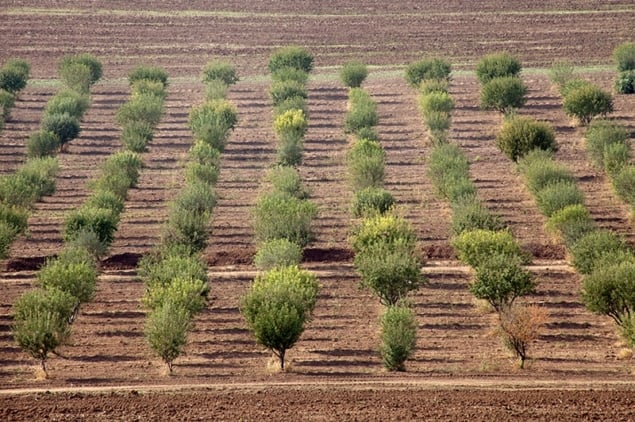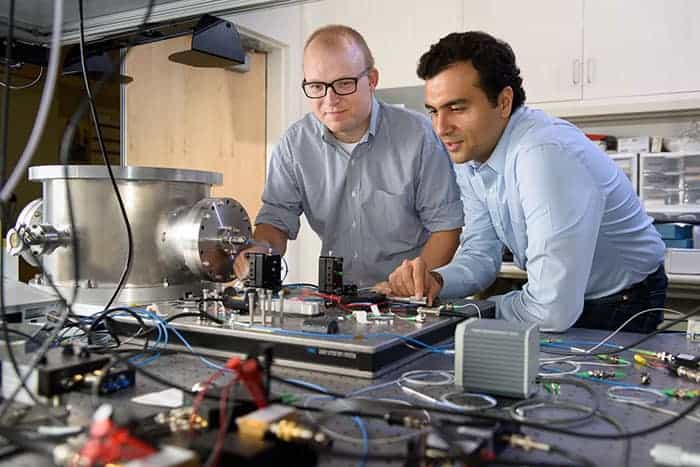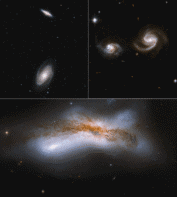
The number of nuts on pistachio trees in any given year could be explained with a model from statistical physics that is normally used to study magnetic materials. That is according to researchers led by Alan Hastings, a mathematical ecologist from the University of California, Davis, who have used the “Ising model” to analyse the yields of pistachio trees in one particular orchard in California. Their work explains why the orchard does not always have a uniformly good crop one year followed by a uniformly bad crop the next, arguing that the patchiness in nut production in certain years is due to interactions between neighbouring trees.
It might seem odd there should be a link between pistachio trees and magnetic materials. But the statistical physics developed to understand systems like magnets or liquid–vapour transitions has been found to apply to a wide range of biological systems, from the flocking of birds to patterns of neural activity in the brain. In particular, various biological systems seem to operate close to a critical phase transition like that in iron when the spin magnetic moments switch from a disordered to an ordered orientation as it is cooled below the Curie temperature.
Close to the magnetic critical phase transition, each spin in the material becomes acutely sensitive to the orientation of the others, with their alignment exhibiting long-range correlations. Patches of aligned spins can therefore develop on all length scales from just a few neighbours to the entire system, making the patches “scale-invariant”.
Useful behaviour
Critical behaviour might be useful in biological systems because it leads to extreme sensitivity to external influences, with the long-range correlations meaning that a small disturbance can spread rapidly through a system. The system therefore has access to many different configurations and will not get trapped in a particular arrangement. Indeed, biological systems might deliberately sit close to critical points to benefit from this responsiveness – a flock of animals, for example, could then quickly adapt to the presence of a predator.
Hastings and colleagues have now applied this knowledge to explain the patterns of nut productivity among 6700 pistachio trees in the Lost Hills orchard in Kings County, California. Based on data from automated harvesting equipment that shakes trees and catches the nuts, they noticed that in 2005 and 2007 almost all the trees gave a high yield, while 2006 was a “resting year” when yields were uniformly low. That one-year-on, one-year-off behaviour is normal for fruiting trees.
Lattice of trees
For 2003 and 2004, however, the distribution of yields was patchy – but not entirely random. The patches of productive and unproductive trees varied from large to small, in a way that resembled the scale-invariance of a critical point. The researchers were able to reproduce these statistics using the Ising model for magnetic materials, in which each spin is arranged on a regular grid-like lattice – like the gridded planting of the nut trees – and can adopt just one of two oppositely aligned orientations.
Neighbouring spins interact with each other via their magnetic moments, but they can also be influenced by an external applied magnetic field. For the nut trees the equivalent variable to the alignment of spins is the productivity: each tree could be in the high- or low-yielding phase of its cycle.
Hastings and colleagues found that the 2D Ising model predicts the same statistics as those observed for the scale-invariant spatial correlations between trees in 2003–2004. They also confirmed that the correlations decay with distance in the orchard as a power law with an exponent of 1/4, as seen in a 2D Ising model. As for the uniformity of nut production in 2005–2007, the researchers say this is more like an Ising model in a strong external magnetic field, which enforces the orientation of all spins. The equivalent of this external field for the trees is some environmental factor, such as the weather, which drives high or low productivity for all trees.
Root of the problem
But if the orchard is acting like an Ising magnet, what causes the interaction between neighbouring trees that encourages them to synchronize their on–off cycles? Hastings’ team says trees could potentially influence one another via pheromone-like molecules emitted from leaves or through acoustic signals, although the likeliest cause is “intraspecific root grafting”, whereby the roots of one tree latch onto and merge with those of a neighbour.
However, Walter Koenig – an ecologist at Cornell University who was not involved in the work – points out that the spatial synchrony of seed production in many forest trees can occur over hundreds of kilometres, which means that other factors must be at play in driving such synchrony. “On such a large geographic scale, it is unlikely to be driven by shared resources of trees that are interconnected by grafting and/or underground networks,” he says.
Neighbourhood gossip
The research is described in the Proceedings of the National Academy of Sciences and James Sethna, a statistical physicist from Cornell University in Ithaca, New York, who was also not involved in the work, calls the report “a wonderful paper”. He adds, “It’s a surprise to me, though maybe not to those in the field, that pistachio trees talk with their neighbours. It’s also a surprise that the trees talk just strongly enough that, in the absence of strong weather effects, they are just on the border of synchronization. Maybe the trees gain some other benefit by communicating, but would pay a big penalty for locking together so much that they can’t adapt to climate variations.”

New Ising-machine computers are taken for a spin
However, Tamás Vicsek, a statistical physicist from the Eötvös Loránd University in Budapest, Hungary, is less sure that the researchers have yet found the best way to model their findings. “I don’t see how root grafting would result in a ferromagnetic-type interaction [synchrony of neighbouring on–off cycles]”, he says. Such fractal-like patchiness is quite common in ecology, he says, but “I wouldn’t put money on the Ising model being the best explanation.”
All the same, Sethna thinks that the evidence of a coupling will interest those studying ecosystems and agricultural systems. “One could envision incorporating the locations of hills, ponds and roads, and the random spacings between neighbouring trees, into a large-scale model of pistachio groves all over California,” he says, “predicting the crop yields by estimating the distance and soil dependence of the couplings and the weather dependence of the external forcing, to allow farmers to plan their finances.”



